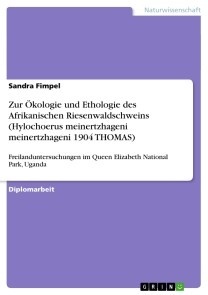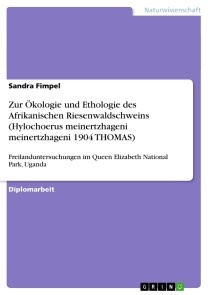Zur Ökologie und Ethologie des Afrikanischen Riesenwaldschweins (Hylochoerus meinertzhageni meinertzhageni 1904 THOMAS)
34,99 €
inkl. 7% MwSt. und
ggf. zzgl. Versand
Diplomarbeit aus dem Jahr 2002 im Fachbereich Biologie - Verhalten, Note: 1,0, Freie Universität Berlin (Institut für Biologie - Zoologie), Sprache: Deutsch, Abstract: Data was collected over a period of six months on aspects of the ecology and behaviour of wild groups of the Giant Forest Hog (Hylochoerus meinertzhageni meinertzhageni, THOMAS) in the Queen Elizabeth National Park, Uganda.Forest Hog social groups consist of one boar, one to four sows and their offspring. Other pigs usually do not allow a boar to join a family group apart from during the mating season. The effect of dominance hierachy was observed for both sexes on the following behaviours: leading the group, protection of the home range, protection of the sows against extra-group males and behaviour in presence of predators. The results reveal that Forest Hogs do not show any hierarchy within the group and all adult animals seem to be responsible for all group members. However, data suggests that there may be an alpha sow, who might be the centre of group coordination.Raising piglets resembles that seen in other pig species, such as the European Wild Boar (Sus scrofa), but in case of loss of fitness of the mother the piglets are fed by other mothers. This seems to be initiated by the young, which means that it is more an act of allosucking than allosuckling. The piglets quickly begin to build up relationships with all other group members. The father-child-bond is very strong during the period of weaning. Play and interaction with other species are included in this work as a photo-documentation. The dry season causes changes in the environment that are unusual for the typical habitat of the Giant Forest Hog. Two groups with neighbouring home ranges were observed and compared in several aspects of behavioural adaptation: change of food plants, migration within the home range and splitting up in subgroups.The vocalizations of Forest Hogs were recorded and partly analysed with sound analysing software. The different calls were classified by context and manner of production: there are creaking, grunting, puffing, squeaking and screaming sounds that make up the different calls. The voice development from piglet to adult animal, individual differences in contact calls and differences between calls that sound similar but have a different meaning are shown in spectrograms.

- Autor: Sandra Fimpel
- Seitenzahl: 137
- Format: EPUB
- DRM: social-drm (ohne Kopierschutz)
- Erscheinungsdatum: 21.04.2009
- Herausgeber: GRIN VERLAG
